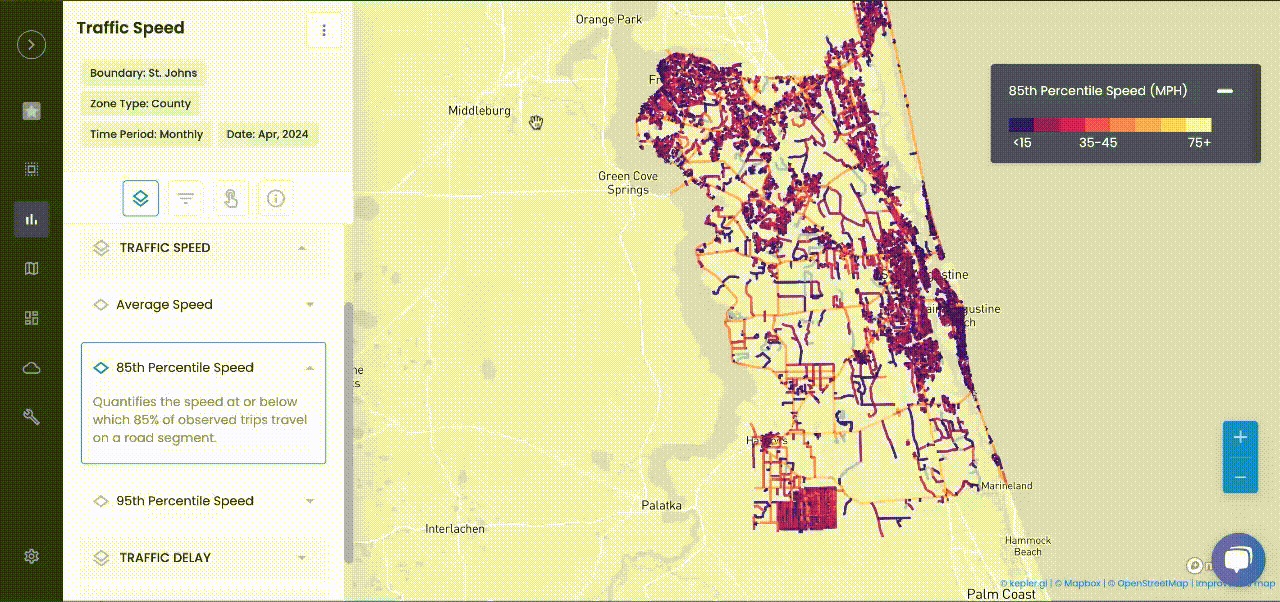
Road Safety
How Cities Use Collision Index to Prevent Dangerous Crashes and Save Lives
Using Collision Index and data intelligence to prevent fatal roadway crashes
A Collision Index helps cities identify high-risk roads, reduce crashes, and proactively plan safer, smarter infrastructure projects.
Cities today have a powerful new tool for proactive road safety: the collision index. Built from historical crash data, traffic volumes, speed patterns and road features, the collision index scores each street segment for collision risk. Mapping this index over a city instantly reveals hotspots – the corridors where serious crashes are most likely. Officials can then zoom in on segments with scores near 1 (highest risk) to see underlying causes. The map below is an example: high-risk roads (orange/red) stand out clearly against lower-risk streets (purple), guiding planners to the most dangerous areas.
Identifying Hazards Before Crashes Occur
Rather than waiting for another crash report, cities use collision indexes to identify danger in advance. The index aggregates multiple years of fatal crash counts with factors like speeding and road design, producing a risk score for every block. This lets planners visualize the High Injury Network – the handful of roads that account for most severe crashes. For example, a city might filter all segments by top-20% collision index and highlight them in the GIS system. Those hotspots clearly flag where “Vision Zero” countermeasures are needed. As one expert notes, officials can “pinpoint hotspots across their entire roadway network” by using this data.
By charting index trends over time, agencies also close the loop on safety. Data dashboards can compare collision rates before and after an intervention. If a new speed camera or crosswalk is installed, analysts track whether the collision index and actual crash counts fall. In this way, collision indexing not only identifies danger but also measures the effect of actions – ensuring that roadways remain safe following the implementation of countermeasures.
Prioritizing Safety Projects and Funding
One of the greatest benefits of a collision index is data-driven prioritization. When city leaders prepare safety or infrastructure budgets, having clear, visual evidence of danger helps win approval and funding. High collision index scores can guide the list of projects submitted to state or federal grants.
For instance, planners can overlay the index map on proposed road diets, signal upgrades or sidewalk extensions, showing stakeholders exactly where and why each project is needed. As a city planner explained, such data helps planning officials decide which road projects to fund.
Likewise, collision index maps can support grant applications. Programs like USDOT’s Safe Streets for All (SS4A) or local safety initiatives award funds based on data-driven needs. A heat map of collision index by neighborhood makes a compelling case for allocating resources to the worst-off areas. One analysis notes that this data enables public works departments to craft maps of dangerous roadways that the public can use and justify safety investments. In practice, cities using collision indexing have seen more transparent, data-backed decisions about where to rebuild curbs, install crosswalks or improve lighting.
Examples of safety projects guided by collision data include:
- Road diet conversions. Reducing a four-lane undivided street to three lanes (adding a center turn lane) can cut crashes by roughly 20–45%. Cities spot high-index streets with severe crash patterns and reconfigure them to calm traffic.
- Traffic calming installations. At high-risk residential roads, cities add speed humps, chicanes or curb extensions. These slow cars and shorten pedestrian crossings. (For example, one study found a 37.5% drop in child-pedestrian collisions after speed hump installation.)
- Signal and crossing upgrades. Intersections with high collision scores may get longer walk signals, leading pedestrian intervals or upgraded signage. Improving signal timing can notably improve safety at busy junctions.
Each of these interventions can be pointed to on a map showing collision index. By targeting limited engineering dollars to index hotspots, cities maximize lives saved per project.
Targeted Enforcement and Community Action
Collision indexing also helps police and neighborhoods act in the short term. High index areas become priority zones for speed enforcement, sobriety checkpoints or traffic patrols. Law enforcement can plan overtime shifts and deploy automated speed cameras on just those blocks with the worst crash history.
In New York City, for example, placing speed cameras in problem corridors led to a 55% drop in fatalities and a 63% drop in speeding in school zones. With a city-wide risk map, other jurisdictions can apply the same strategy: put eyes (and enforcement) on the streets where cars most endanger people.
Data also empowers community outreach. Cities can share index maps with neighborhood groups, showing citizens why certain streets are “dangerous.” Local engagement such as meetings with residents on high-index blocks helps tailor solutions (e.g. signage, crosswalks or education). Feedback signs and traffic-slowing street art might follow once an index identifies a risky corridor. As Urban SDK COO Justin Dennis notes, collision data can lead to more law enforcement attention for those spots and eventual improvements. In short, the index not only signals where trouble is but also mobilizes both authorities and communities to stop crashes before they happen.
Cities are already putting this into practice. For example, the City of Camas, Washington – a suburban community of 26,000 – partnered with an AI traffic platform to address growing traffic safety concerns and better identify accident hotspots. As Dennis, explains, collision data gives cities the visibility they need to direct law enforcement to the right places—and ultimately drive real safety improvements. In short, the Collision Index doesn’t just identify danger; it empowers both city officials and communities to take proactive steps that prevent crashes before they happen.
Camas leaders use the collision index and accompanying speed data to guide traffic calming and enforcement initiatives. Likewise, hundreds of municipalities (over 165 and counting) now access collision risk maps to inform daily enforcement plans and respond swiftly to citizen complaints.
From Data to Results: Saving Lives
Collision indexing is powerful because it closes the gap between knowing the danger and doing something about it. By pinpointing trouble spots, it focuses city efforts where they matter most. Studies show that data-driven countermeasures work. For example, automated speed enforcement (aided by hotspot data) produced a 55–60% reduction in NYC’s severe crashes. Road diets have cut total crashes by up to 47% on selected corridors. Each of these outcomes aligns with a drop in the collision index after improvements—meaning fewer lives lost.
Importantly, collision indexing helps cities move beyond reactive fixes. Rather than only responding after a tragic crash, planners can now predict which streets need attention next. This proactive approach is at the heart of Vision Zero and modern traffic safety strategies. As one safety official put it, having index-based analytics means “officials can proactively determine where to allocate resources” and “continuously monitor trends” in crash risk. In practice, that means fewer surprises and more prepared communities.
FAQs
Q1: What is a Collision Index and why is it important?
Ans: A Collision Index is a data-driven score that ranks road segments by their relative crash risk, combining crash history, traffic volume, speed patterns, and road/design features. It helps cities identify high-risk corridors to focus safety efforts proactively.
Q2: How is the Collision Index calculated?
Ans:The index uses statistical or machine learning models on multi-year crash data weighted by severity, traffic exposure metrics, vehicle speeds, road geometry, and neighborhood context. This approach normalizes risk for fair comparison across different roads.
Q3: How do cities use the Collision Index for safety planning?
Ans: Cities map collision scores to visualize high-risk roads (the "High Injury Network"), prioritize countermeasures like road diets or signal upgrades, and apply for safety grants with compelling, data-backed evidence.
Q4: Can the Collision Index track the effectiveness of traffic safety interventions?
Ans: Yes. By analyzing before-and-after trends in collision scores and crash counts, cities measure the impact of projects such as new speed cameras, pedestrian crossings, or traffic calming, enabling continuous improvement.
Q5: How does the Collision Index support enforcement and community outreach?
Ans: Law enforcement can target patrols, sobriety checkpoints, and automated speed cameras to highest-risk areas. Sharing index maps with communities builds awareness, encourages local participation, and fosters support for safety initiatives.
Q6: Are there real examples of cities using the Collision Index effectively?
Ans: Yes. Cities like Camas, Washington use collision data combined with speed analytics to guide enforcement and traffic calming, improving safety outcomes. In NYC, speed cameras deployed using hotspot data cut fatalities by 55% and speeding by 63% in school zones.
Q7: What are the broader benefits of using the Collision Index?
Ans: It moves cities from reactive crash response to predictive safety management, helps allocate limited resources where they save the most lives, supports transparent and data-driven decision-making, and aligns with Vision Zero goals.

TRAFFIC ENFORCEMENT FEATURES
80% of citizen complaints
are a perception problem
Urban SDK provides precise hourly speed data to evaluate complaints and deploy resources efficiently for the greatest impact to public safety.
Urban SDK provides precise hourly speed data to evaluate complaints and deploy resources efficiently for the greatest impact to public safety.
Target Speeding
Identify hot spots, validate monthly speeding trends and monitor vulnerable areas like school zones.
Improve Safety
Crash and citations location information to compare speed trends month over month
Fast Response
Respond to citizen complaints sooner with address search and exportable reporting
Deploy Assets
Generate maps for traffic enforcement by time of day, location or division to deploy officers to known problem areas.
RESOURCES
Customer Success
See how public sector leaders succeed with Urban SDK.
WEBINAR
Identify speeding and proactively enforce issues
See just how quick and easy it is to identify speeding, address complaints, and deploy officers.







